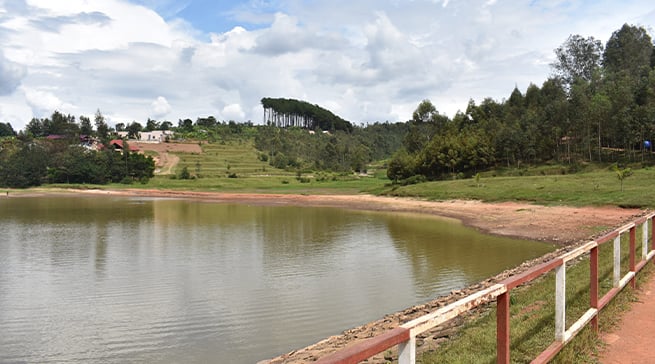RAB sheds light on the issue of silted artificial Lakes used for rice Irrigation
The Rwanda Agriculture and Animal Resources Development Board (RAB) has addressed the issue of artificial lakes used for rice irrigation that have become silted, as highlighted by Hitayezu Jerome, RAB’s irrigation officer.
Jerome mentioned that the rehabilitation of these lakes is set to commence next year, but farmer cooperatives should be encouraged to perform early maintenance to avoid high repair costs that exceed their financial capacity.
For example, Lake Rugeramigozi has seen a significant drop in water levels, preventing farmers from growing rice. Jerome explained that while projects such as CDAT will rehabilitate lakes like Cyabayaga, Base, and Kiriba, Lake Rugeramigozi, which no longer supports rice farming due to low water levels, will be desilted in collaboration with Muhanga District, RAB, and WASAC.
Jerome noted that the reduction in water storage capacity has adversely impacted productivity as irrigation reaches fewer fields, and the available water is insufficient. “Production has decreased because the water doesn’t reach all areas. Rugeramigozi used to support rice cultivation, but now farmers are forced to plant beans instead. These are the consequences of the silt buildup,” he stated.
He added that while repairing these lakes is expensive, farmer cooperatives, which manage water resources, currently lack the capacity to fund the repairs. However, after the rehabilitation, they will be trained and empowered to maintain the infrastructure to prevent future siltation.
Despite Jerome’s assurances, farmers lament the significant financial losses incurred due to the inability to grow rice. Ismael Ntakirende, a leader of rice farmers under the COPRIMU Cooperative, shared that his plot, which used to yield between 800-900 kg of rice worth around 400,000 Rwandan Francs (Frw), now produces only 500 kg of maize, bringing in just 120,000 to 150,000 Frw.
“The difference is clear. When I farmed rice, I could earn up to 800,000 Frw annually, but now, with maize, I make less than 300,000 Frw. That’s not progress; it’s a setback. We need support to return to rice farming,” he urged.
The COPRIMU cooperative, which used to cultivate 12 hectares of rice, is now forced to grow other crops, and farmers who had already bought fertilizer before the water shortage are struggling to pay for inputs they could not use.
Aisha Umurerwa, the finance officer of the CODERVAM Cooperative, also highlighted that water shortages have delayed cultivation on nearly 300 out of 400 hectares, which will negatively impact the expected yields. “We wrote to the District recently because we saw that 300 hectares could be lost. This delay will affect yields since we are still planting instead of doing secondary weeding and applying fertilizers.”
Anatole Maniraguha, the leader of CODERVAM’s water users, said the problem began in 2015 when the Ngoma dam was damaged, and they have since been using makeshift methods, such as earth-filled bags, to channel water. “We cannot afford to rebuild the dam, so we use temporary measures. This reduces irrigation capacity, leading to poor yields as farmers harvest only 60% of what they expect.”
He called for the urgent repair of the Ngoma dam and the newly constructed Karungeri dam to begin operations soon. Additionally, Maniraguha emphasized the need for the Cyabayaga artificial lake to be desilted to increase its water retention capacity.

